Is marketing during COVID-19 necessary?
On one side, only 37% of consumers want brands to continue to advertise as normal, according to GlobalWebIndex.
On the other, history shows that marketing during times of crisis has had a positive impact on brand awareness and affinity, revenue, and market share.
Today, striking a balance between these two is crucial. Customers expect brands to maintain influence, but not in a way that takes advantage of the situation for the sake of profit.
Quick lessons from history
In his book, David Ogilvy shared a chart comparing the net income of companies that cut back on advertising during the 1974-75 recession with those that did not. By 1977, the net income of companies that did not cut back tripled, while the others hardly doubled.
Another example he provided was a Unilever margarine brand. The British Government prohibited the marketing of margarine under brand names during WWII. Unilever continued to advertise. When the war ended and brands returned, the Unilever margarine brand was number one in it’s category.
25 brands putting with the right tactics for marketing during COVID-19
Marketing is crucial even during difficult periods. We have examined 25 brands and their leading tactics for staying top-of-mind through marketing during COVID-19.
Ensuring customers of safety initiatives
People have become more skittish when it comes to health and cleanliness. To ensure the safety of customers and workers, brands have implemented precautionary measures.
- Dunkin’ Donuts recently shared new health initiatives on social media. They also heavily feature front-line workers and promote new ways of buy their products.
- DoorDash promoted its precautionary measures with a positive testimonial (retweet) on Twitter. This encourages community engagement and underscores social validation.
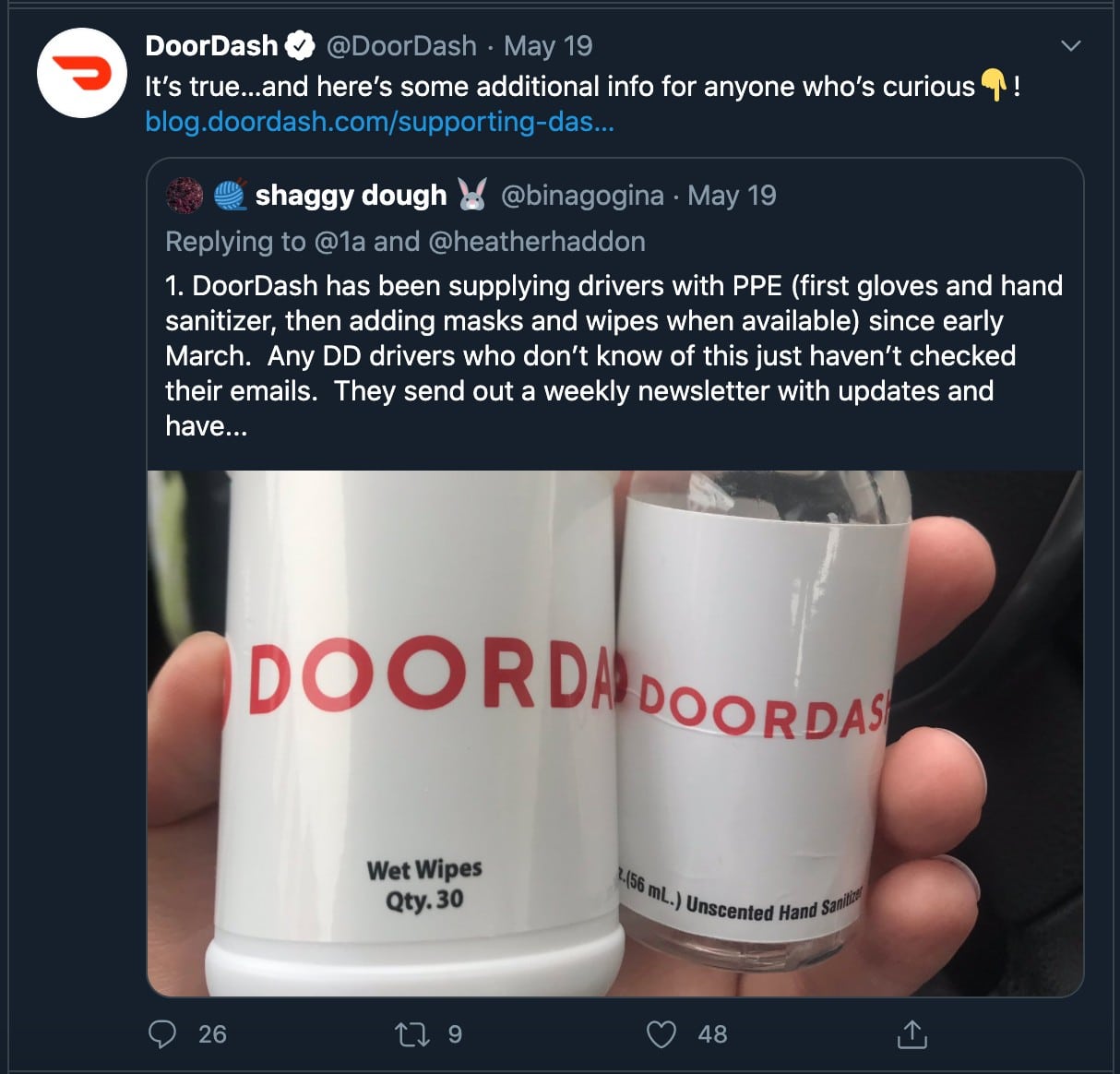
Helping front-line workers
Brands—big and small—rolled out different ways to help front-line workers. Some encourage customers to donate directly through their website or app while some offer their services for free.
- Grab provides users the option to buy food for their drivers instantly on the app. This feature was especially beneficial during the first weeks of staying at home when drivers faced a surge of online orders.
- Talkspace allots 1,000 months of free online therapy via its platform to medical and healthcare responders.
Offering free access
In times of crisis, getting high-quality information is imperative as it informs consumers and businesses on ways to manage difficulties. As a result, some brands have offered their products and services for free.
- New York Times has most of its COVID-19 coverage and resources available for free. Other organizations that do the same are MIT Press, The Lancet, and more.
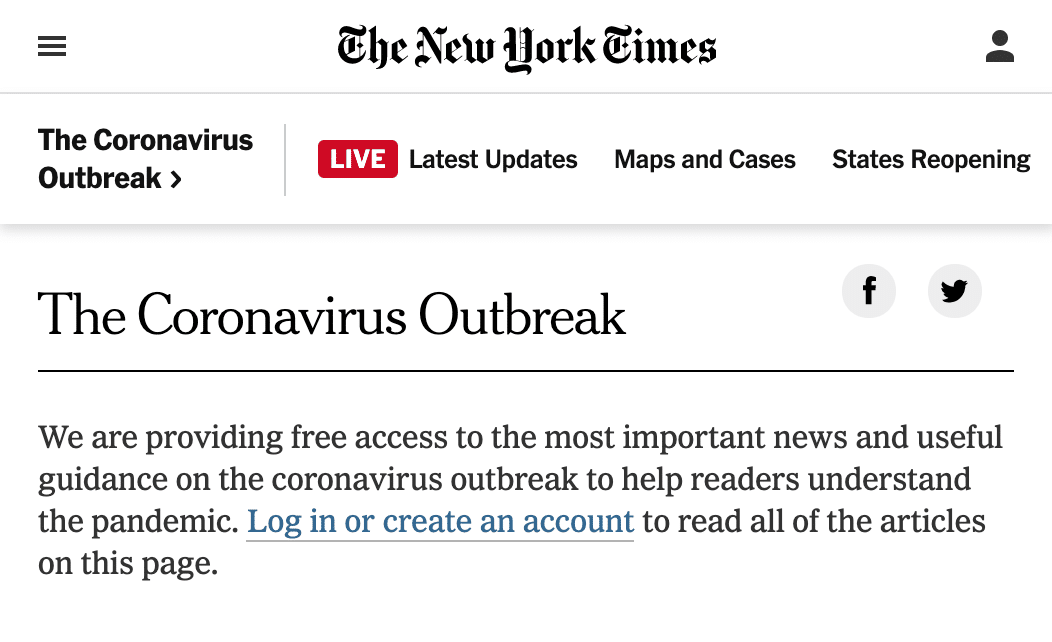
- HBO, up until April 30th, offered a lot of their series and movies for free on HBO Now and HBO Go. Other streaming platforms that have free events and features include Apple TV+ and Sling TV.
- Qualtrics helps businesses, governments, and academic institutions with a wide range of free digital solutions and recommended timeline for execution—from remote work assessments to customer care.
- Kahoot! provides teachers free access to their premium distance learning tools until schools reopen.
Repurposing production lines
As demand for apparel dipped, many retailers were able to contribute to the relief efforts by repurposing their production and R&D capabilities.
- LVMH is one of the first luxury brands to convert their perfume manufacturing facilities to make hand sanitizers, given for free to hospitals and healthcare centers.
- Under Armour is helping out healthcare providers with face masks, face shields, hospital gowns, and specially equipped fanny packs manufactured and assembled in their product innovation laboratories.
Using wit without overstepping boundaries
Without a doubt, we’re going through hard times. But for some brands, maintaining their already light and entertaining brand voice helps bring people together.
- Old spice, known for its aggressive yet humorous branding, has repurposed existing clips to make a new one that’s more relevant to the current crisis. See the short video on Instagram that encourages people to “Stay insiiiide!”
- Ligo uses witty captions and visuals to encourage people to follow government policies of social distancing. Translation: “Ok, let’s do social distancing for now!”
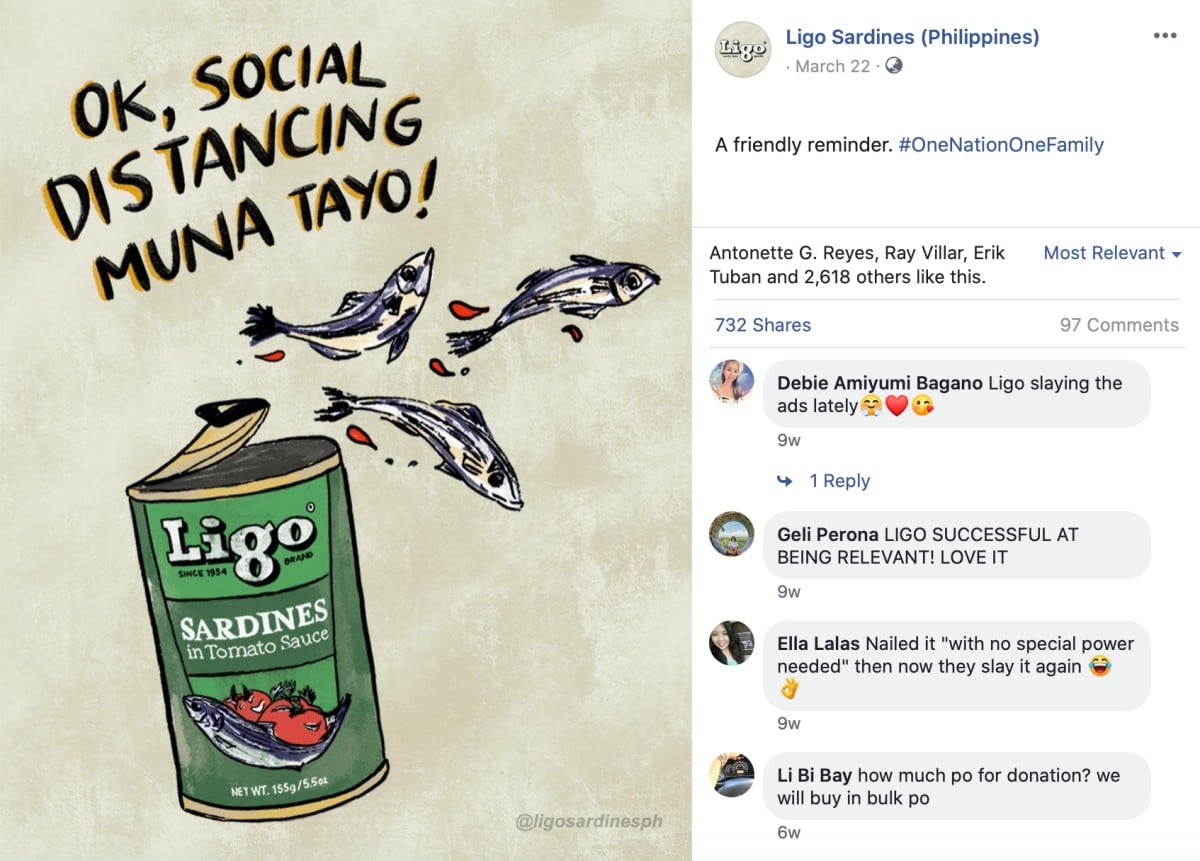
- Greggs engages users by replying to a post on Twitter with a comeback that resonates well with their customers… who legit miss their products. The tweet is best viewed with video and sound so see it here.
- The Honest Company connects with customers, mostly mothers, with content that’s highly relatable and funny.
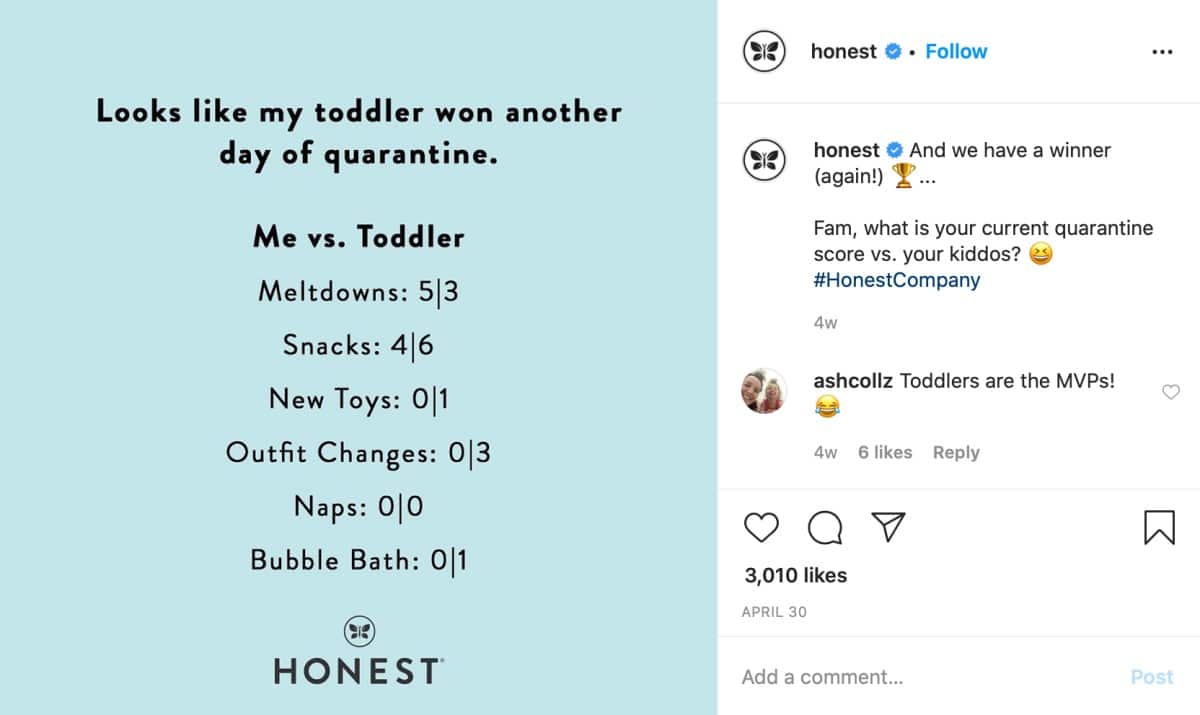
Unifying customers while staying at home
Since the movement of people worldwide has been limited, brands got creative on social media with activities that make being at home more enjoyable.
- Dr. Pepper posted backgrounds for Zoom that workers can use to spice up work video calls. Visit their website to see.
- IKEA, home of the famous Swedish meatballs, shared the meatballs recipe on Instagram so people can recreate them at home. They even had one of their employees cook some meatballs to show that the recipe works.
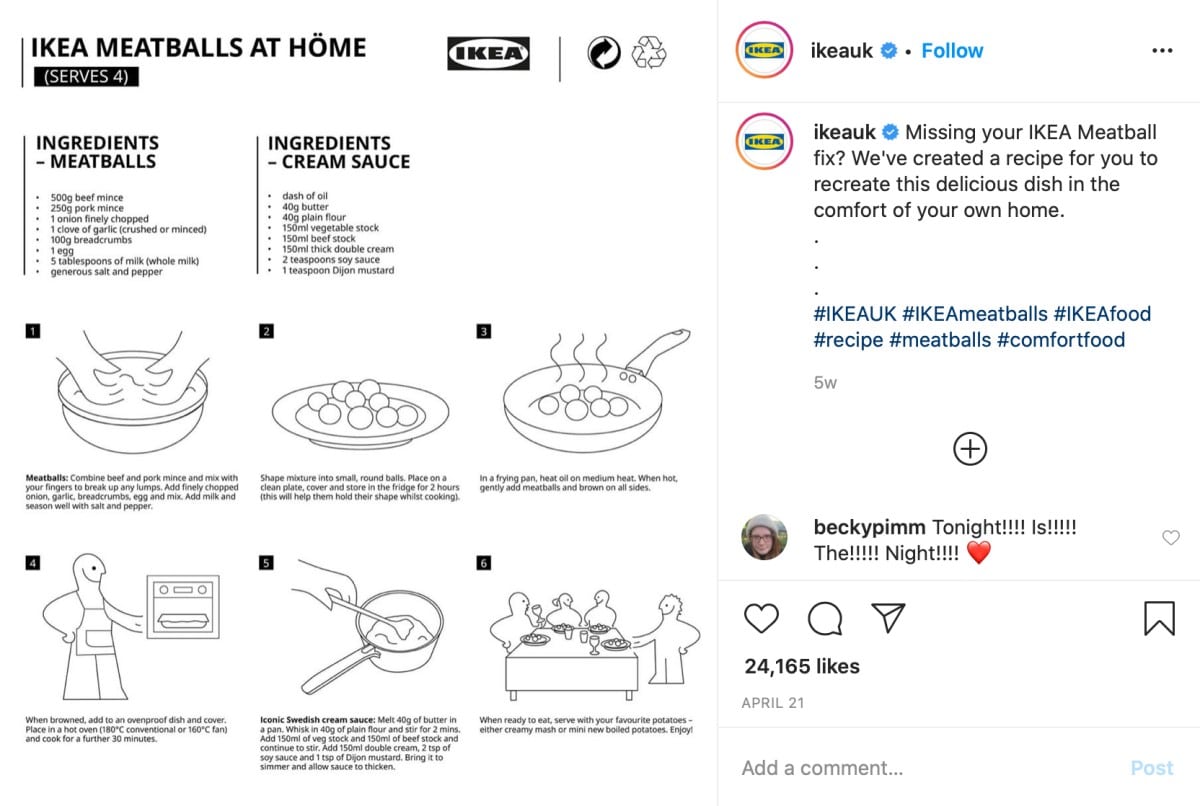
- American Eagle had a virtual concert series called “Come Together: At Home with AE” featuring artists such as Jojo and Tinashe. During the live streaming, fans donated through AE’s channels while AE matched donations up to $100,000.
- Sunnies Studios created a separate Instagram account with a tagline “indoor fun” to keep customers occupied with online games. The brand also had virtual workouts and even DJ sessions.
Supporting partners and customers
For some brands, mitigating the economic impact for customers and partners means offering financial assistance or payment term flexibility.
- Cisco launched a $2.5 billion financial relief program that features a 90-day payment holiday, allowing customers to defer 95% of new product or technology costs until 2021.
- Airbnb announced a $250 million relief fund for hosts severely affected by the pandemic. The company committed a 25% refund for canceled reservations, as well as a by-invitation-only financial aid for Superhosts.
Promoting local
COVID-19 has impacted businesses of all sizes, most severely, those on a local level. In an effort to relieve some of their difficulties, larger brands have introduced initiatives that highlight and support local businesses in particular.
- TripAdvisor introduced #LoveYourLocal, encouraging users to buy from local restaurants and other favorites, write reviews about them, and share on social media.
- Sun Bum asks website visitors to first check if their local surf shop’s online store is carrying what they’re looking for.
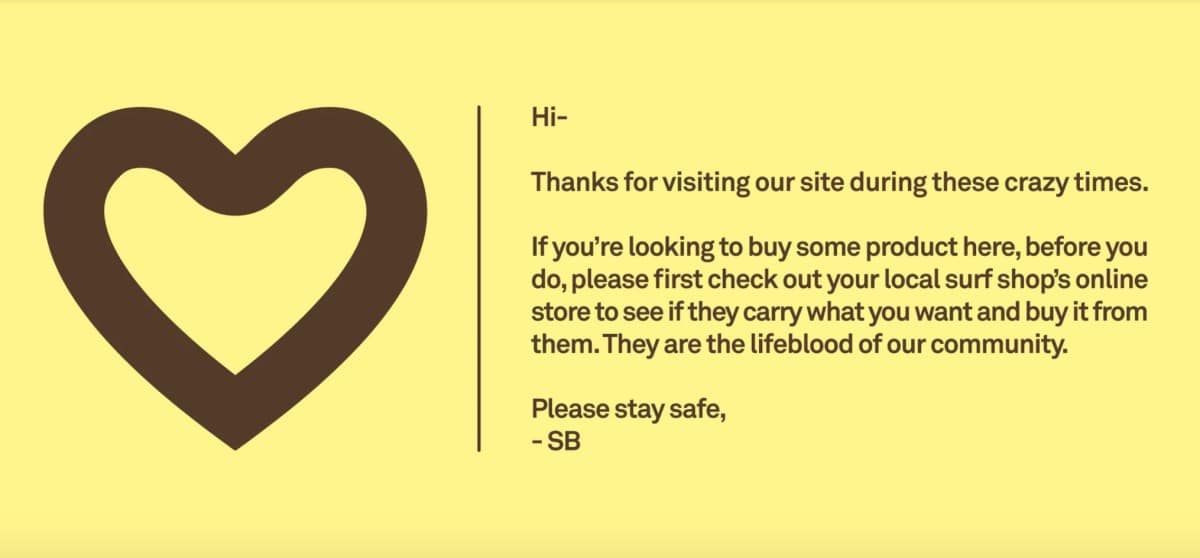
- Corkcicle added a new section on its checkout page that allows customers to support their local retailers. This initiative credits the customers’ store of choice with the amount of their purchase.
Donating to causes
In several countries, including the United States, United Kingdom, and Brazil, consumers look to large corporations to lead the response to COVID-19.
- Shell, the third-largest company in the world, has various initiatives in countries where they’re operating. Examples include donating $3 million to Mercy Corps’ resilience fund, producing 2,700 reusable face shields in Canada, distributing 9,500 care kits to ambulance and truck drivers in India, and more.
- Ralph Lauren pledged $10 million through the Ralph Lauren Corporate Foundation. They also collaborated with US manufacturing partners to produce thousands of masks and gowns.
Engaging customers in the right way when marketing during COVID-19
More stats from the GlobalWebIndex reveal that 43% of consumers find it reassuring to hear from the brands they know and trust. In particular, 56% are “pleased to hear about brands taking actions like making donations of goods and services.”
For the most part, customers want to be affiliated with brands that match their lifestyles and principles. Combining unique voice and customer connections with genuine efforts to help, brands can make marketing during COVID-19 an opportunity for connecting the world around them and improving the future.